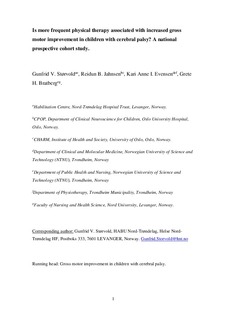| dc.contributor.author | Størvold, Gunfrid Vinje | |
| dc.contributor.author | Jahnsen, Reidun | |
| dc.contributor.author | Evensen, Kari Anne Indredavik | |
| dc.contributor.author | Bratberg, Grete Helen | |
| dc.date.accessioned | 2019-02-11T16:12:23Z | |
| dc.date.available | 2019-02-11T16:12:23Z | |
| dc.date.created | 2018-12-27T21:23:20Z | |
| dc.date.issued | 2018 | |
| dc.identifier.citation | Disability and Rehabilitation. 2018, . | nb_NO |
| dc.identifier.issn | 0963-8288 | |
| dc.identifier.uri | http://hdl.handle.net/11250/2584891 | |
| dc.description.abstract | Purpose: To investigate the association between physical therapy frequency and gross motor improvement in children with cerebral palsy (CP).
Materials and methods: This is a prospective cohort study of 442 children aged 2–12 years, Gross Motor Function Classification System levels I–V, from the Cerebral Palsy Follow-up Program and the Cerebral Palsy Register of Norway. Outcome was change in reference percentiles for the Gross Motor Function Measure (GMFM-66) between two subsequent assessments (N = 1056) analyzed in a linear mixed model.
Results: It was a dose response association between physical therapy frequency and gross motor improvement. Mean change was 4.2 (95% CI: 1.4–7.1) percentiles larger for physical therapy 1–2 times per week and 7.1 (95% CI: 2.6–11.6) percentiles larger for physical therapy >2 times per week, compared to less frequent physical therapy when analyzed in a multivariable model including multiple child and intervention factors. The only statistically significant confounder was number of contractures which was negatively associated with gross motor improvement.
Conclusions: When gross motor improvement is a goal for children with CP, more frequent physical therapy should be considered.
Implications for rehabilitation
- In general, the gross motor development of Norwegian children with cerebral palsy was as expected according to the reference percentiles for the GMFM-66.
- When gross motor improvement is a goal for children with cerebral palsy, high-frequency physical therapy should be considered.
- Contractures should be addressed in order to optimize gross motor improvement for children with cerebral palsy. | nb_NO |
| dc.language.iso | eng | nb_NO |
| dc.publisher | Taylor & Francis | nb_NO |
| dc.title | Is more frequent physical therapy associated with increased gross motor improvement in children with cerebral palsy? A national prospective cohort study | nb_NO |
| dc.type | Journal article | nb_NO |
| dc.type | Peer reviewed | nb_NO |
| dc.description.version | acceptedVersion | nb_NO |
| dc.source.pagenumber | 9 | nb_NO |
| dc.source.journal | Disability and Rehabilitation | nb_NO |
| dc.identifier.doi | 10.1080/09638288.2018.1528635 | |
| dc.identifier.cristin | 1647477 | |
| dc.description.localcode | This is an Original Manuscript of an article published by Taylor & Francis in Disability and Rehabilitation on 05.01.2018, available at https://doi.org/10.1080/09638288.2018.1528635 | nb_NO |
| cristin.unitcode | 194,65,20,0 | |
| cristin.unitcode | 194,65,15,0 | |
| cristin.unitname | Institutt for samfunnsmedisin og sykepleie | |
| cristin.unitname | Institutt for klinisk og molekylær medisin | |
| cristin.ispublished | true | |
| cristin.fulltext | postprint | |
| cristin.qualitycode | 1 | |
